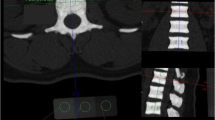Abstract.
The purpose of this study was to evaluate serial changes in bone mineral density (BMD) of the lumbar spine in individual children and adolescents with untreated osteogenesis imperfecta (OI) using dual X-ray absorptiometry (DXA). Twenty-seven pediatric patients with OI who had no historical or radiographic evidence of lumbar fracture, required no assistive device for mobility, and were taking no medications known to affect skeletal mineralization during the study period comprised the investigational group. Absolute BMD and age- and gender-matched BMD (Z-scores) were assessed relative to standard parameters of growth (height, weight, age, height adjusted for age and gender and body surface area) and severity of disease (lifetime fracture rate). The spinal mineralization rate (SMR) between examinations for 15 patients with more than one measurement (n= 20 intervals) was expressed as the magnitude of the change in BMD Z-score per year. Both BMD and BMD Z-score were closely correlated with height, height Z-score, weight and body surface area and were inversely related to fracture rate (P < 0.001 for all comparisons). BMD was also highly correlated with patient age (P < 0.001). Stepwise regression analysis showed that together height Z-score and lifetime fracture rate improved the prediction of BMD Z-score (r= 0.71; P < 0.001). SMRs ranged from −0.5 to 3.5. The average change in SMR between sequential measurements was 168% for the five children who had more than two DXA examinations. Linear regression showed a significant negative correlation between SMR and height Z-score (r=−0.79, P < 0.001). We conclude that vertebral body size is a critical determinant of BMD and BMD Z-score in OI because DXA results are expressed per unit area, not per unit volume. Pediatric patients with OI mineralize their lumbar vertebrae at rates similar to healthy children but tend to lag behind in overall mineralization. The rate of mineralization at any age appears to be related to the patient's height (adjusted for age- and gender-matched controls) and inversely related to the patient's lifetime rate of fractures. Our data suggest that vertebral mineralization in children with OI is related primarily to rapid increases in vertebral volume and only secondarily to increases in vertebral mineral density.
Similar content being viewed by others
Author information
Authors and Affiliations
Additional information
Received: 2 March 1997 / Accepted: 5 June 1997
Rights and permissions
About this article
Cite this article
Reinus, W., McAlister, W., Schranck, F. et al. Differing Lumbar Vertebral Mineralization Rates in Ambulatory Pediatric Patients with Osteogenesis Imperfecta. Calcif Tissue Int 62, 17–20 (1998). https://doi.org/10.1007/s002239900387
Published:
Issue Date:
DOI: https://doi.org/10.1007/s002239900387




